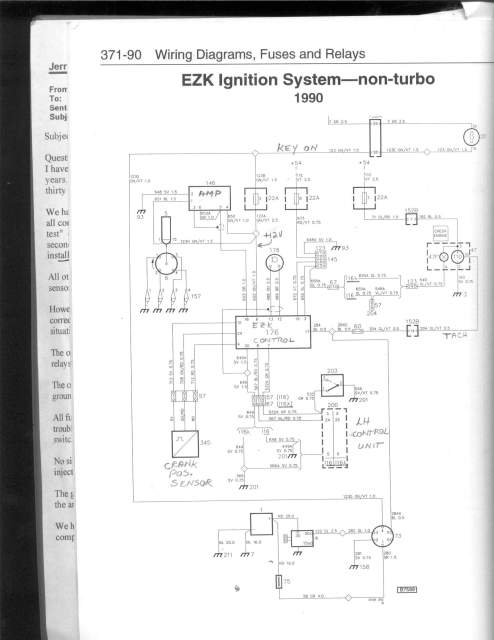QuestionQUESTION: I have a 1990 900S 16V which was recently (two weeks ago) put back on the road after being stored for three years. (Blown head gasket) I had a crank position sensor fail three days ago, installed a new one, and, after about thirty minutes of running, the engine stopped. (no stutter, just shut down)
We have followed all of the procedures in the Bentley manual and the SAAB factory manual and supplements, and all components test as "good" with the exception of the signal amplifier. It fails the "voltage rise on ignition switch test" (voltmeter across terminals 1 and 15 of coil, voltage rise to ca. six volts and return to zero after 1 to 2 seconds.) However, this seems to be a normal failure, and was repeated with all three of the signal amplifiers we installed.
All other component tests also passed, (crank sensor, ignition computer, coil resistance, signal from the crank sensor to the EZK, etc.)
However, we are not detecting a signal at the LH box in the passenger footwell, (1 and 17, if I remember correctly?), and the replacement LH box, (from a previously running 1990 900S 16V), did not change the situation.
The only thing that I have neglected to check is for power to the LH box, however, the main power and fuel pump relays function properly, and were replaced at the same time as the crank sensor.
The only other point that has not been checked was plug 67 in the engine compartment, but I do have continuity to ground through the ground lead from the EZK computer to the LH computer.
All fuses which should relate to this are good and have power, including number seven as suggested in the SAAB troubleshooting supplement, and the tachometer needle does do the "rise and fall" when the ignition is first switched on. Also, all gauges and idiot lights are functioning.
No signal is coming from the LH computer to the injector coils, as verified by the "Noid" light plugged into the #3 injector plug.
The grounds at the engine lifting lug over the intake port of number 4 cylinder are good, as is the the ground above the amplifier and EZK module on the left side of the engine compartment.
We have tested the car with a total of three amplifiers, four EZK boxes, two coils, and two LH boxes, all components were removed from vehicles which were operational at the time of removal.
Suggestions?
ANSWER: Paul:
It is a pleasure to respond to someone knowledgeable like yourself! You must be an engineer!!
Anyway, something you did NOT mention was "the power check to the ignition amp"... checking for 12v between terminals 4(+) and 2(-) of the fender-mounted unit, which if negative, indicates a problem from the ignition switch onward (Bentley sect. 340-9, para. 4). That would cause each of the amps to behave as "identical failures".
Hope this helps, but if not, get back to me for further investigation.
Jerry
PS: The lack of injector signals is still a puzzle, suggesting that the master clocking signal (as from the crank position sensor), is missing. If the ignition switch enable voltage were somehow absent, that would be consistent.
---------- FOLLOW-UP ----------
QUESTION: I will definitely have to check the "power to amplifier" when next I have the chance. (That will be Monday, at the rate things are going. (I work lots of hours on the weekends, and the car is currently under at least a half foot of snow.)) At the moment, I am reduced to penciling checks to make then, and I am wondering if a lack of power to the LH box would cause the signals from the EZK box to ground inside of it. (I did not detect a signal to the LH box when back probing the connector to it.) My understanding of the system sequence is that the EZK box accepts a signal from the crank sensor, (which I have detected on a roll through), sends the signal to the LH computer after integrating the data with input of the knock sensor, which then returns the signal to the amplifier for output to the coil. Is this correct? (I am not at the shop, which has both the car and the manuals.)
If this is the case, then would a lack of power to the LH box cause the series of symptoms that I am seeing here? Or am I misunderstanding the sequence of events?
I know that the LH box controls the injector timing and pulse duration via the data from the crank sensor as interpreted by the EZK, (along with other inputs such as the Mass Air Meter, coolant temp, etc.), but am I correct in believing that the spark is also directly controlled by the LH box? Or is the ignition amplifier directly driven by the EZK?
I believe that I will start from the amplifier voltage check on next opportunity, then move to a voltage input check to the LH controller. Assuming that both of the above are good, would you have a suggestion on where to look next from there?
P.S. No, not a formal engineer, just a hobbyist who used to do this stuff for a living, (unfortunately, I am far more familiar with K-Jet systems!), and still works on SAABs a couple of days a week. (My boss at the shop is as puzzled as I am by this, and he's been in the Swedish/British car repair and restoration business for the last forty-odd years...)
Answer
 EZK Schematic
EZK Schematic
Paul: Your description of the sequence of events is correct; Signals from unit 345(crank pos. sensor) go to Unit 176 (EZK Control) thence to Unit 200(LH Control and return) thence to Unit 146 (EZK Amplifier) and finally to the coil. Loss of 12 volts from the keyswitch via fuse No. 3 would cause all the symptoms you've experienced.
See attached schematic.
